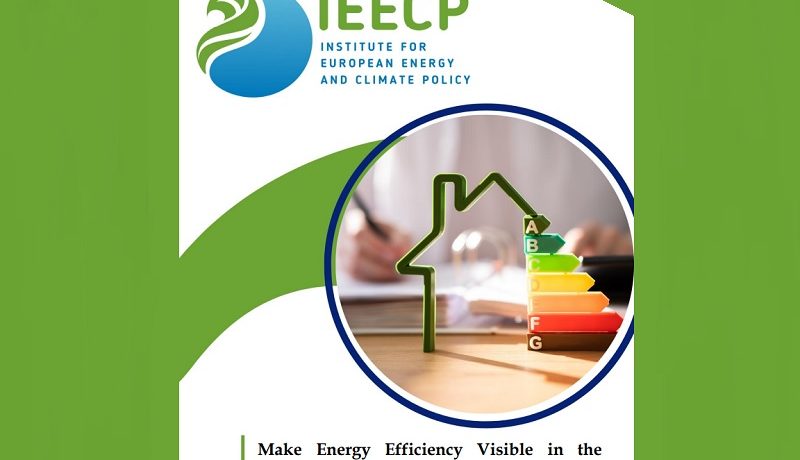Energy Efficiency in the Energy Mix: it is the first fuel for a clean energy future – but not yet visible in the energy mix!
The new Energy Efficiency Directive, adopted last July 2023, enforces the principle of “energy efficiency first” as a fundamental principle of the EU’s energy policy, reflecting the importance that the EU attaches to energy efficiency.
Energy efficiency is considered a core strategy for decarbonisation
A recent report by the IEA estimates that the energy efficiency sector will provide 40% of the necessary greenhouse gas cuts expected worldwide by 2040. A new study by IEECP, “Make Energy Efficiency Visible in the Energy Mix”, outlines the need for energy efficiency to be fully considered as an energy resource, starting with integrating it in the way to represent the energy mix.
Energy efficiency is a resource that we can use to meet our energy needs while consuming less energy. In doing so, we can reduce our energy bills, our dependency on imported fossil fuels, and our CO2 emissions. It has many benefits but is not yet at the forefront of the energy mix at the EU or national level. The energy efficiency share is not included in data representing the energy mix, and therefore, is not a visible component in the energy mix. Out of sight, out of mind: this is one of the reasons energy efficiency does not come first in planning, policymaking, and investment. The new Energy Efficiency Directive has now entered into force and the EU has a stronger legal framework to support energy savings. Looking forward to next year as new European institutions will take office: what should we do to ensure energy efficiency is prioritised and made more visible in the next EU cycle?
Making energy efficiency visible
The IEECP study, supported by Knauf Insulation and the European Climate Foundation, addresses the issue of visibility of energy efficiency in the main publications on energy data. The study highlights how the contribution of energy efficiency is essential to the European Union’s energy system but is not currently visible in the main energy mix figures. Researchers analysed possible ways to add energy savings to national and European Union energy mixes next to energy sources such as renewables, gas and coal in a structured way: 7 actions are listed in the report.
For energy efficiency to be considered on a level playing field with other energy resources, energy efficiency improvements need to be monitored, then energy efficiency data needs to be integrated in the overall energy picture.
“Energy efficiency is considered the first fuel because there is no cleaner and cheaper energy than one that has not been consumed. However, energy efficiency is consistently absent from energy balances which makes it difficult for energy savings to become part of energy strategies. This study redresses that balance by demonstrating the significant contribution that energy savings make to energy mixes along with renewables, gas and coal”, says Katarzyna Wardal-Szmit (Knauf Insulation’s EU Public Affairs Manager).
The fundamental goal of including energy efficiency data into the main energy figures is to keep energy efficiency at the forefront of the broader energy debate.
The study puts energy efficiency back into the energy mix equation.
“The findings provide policymakers and market players with the insight they need to change the perspective on energy systems and give energy efficiency the prominence it deserves in cost-effective and sustainable energy strategies” adds Jean-Sébastien Broc (IEECP researcher and consultant).
More about the study
– The study demonstrates how energy savings can be calculated and better represented to show their critical role in the energy mixes of the European Union and Member States
– It examines how energy efficiency is represented in publications by organisations such as Eurostat, the European Environmental Agency and International Energy Agency and found that when it came to the headline figures of these publications “the quantitative contribution of energy efficiency to the energy mix was missing in the main pictures of the energy balance” while energy efficiency was often included in last chapters or separate reports.
– It integrates 2021 ‘energy savings’ data from the ODYSSEE-MURE project — which has been tracking energy efficiency indicators and strategies in Europe for over 30 years — with Eurostat data on ‘supply’ energy carriers like oil and gas for the EU’s 27 member states.
– It recommends a set of 7 actions to make energy-efficiency more visible, such as for organisations in charge of publications on energy data to charts showing the energy efficiency share next to the shares of the other energy carriers (see figures below). Public authorities and implementing agencies could ensure that results from energy efficiency policies are published on a regular basis as well as monitor and publish the achievements related to major objectives, such as the renovation of the building stock. Energy efficiency experts and stakeholders could complement the regular energy efficiency data with ad-hoc studies providing evidence and key figures about the multiple impacts of energy efficiency, to link the impacts of energy efficiency with what is in the top of the policy priorities (e.g. reducing energy imports).
IEECP is a non-for-profit, independent research foundation working, since 2015, on science-based climate change mitigation, energy efficiency and renewable energy policy, with an international interdisciplinary team of experts generating and disseminating scientific knowledge. We work closely with EU institutions, international organisations, national, regional and local governments, think-tanks, NGOs, academics and the business world to lead the transition to climate neutrality and to a sustainable energy future for various sectors. We build valued partnerships with renowned organisations from across Europe as we believe collaboration and creating a community helps carrying our ideas and results further, to shape, together, a low-emissions, resilient future.
– BYinnovation is Media Partner of IEECP

